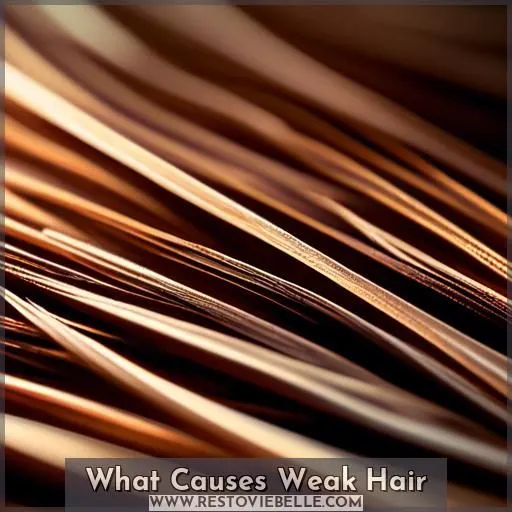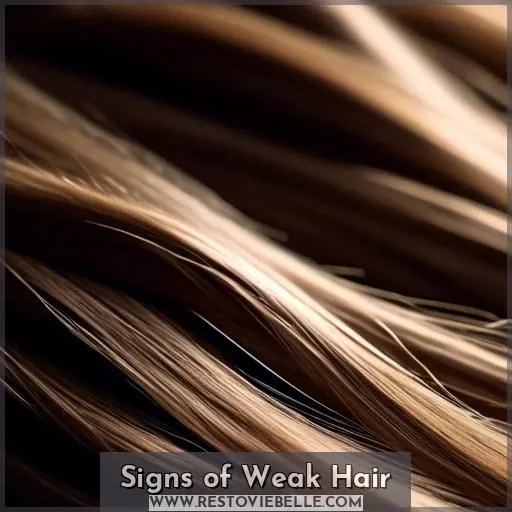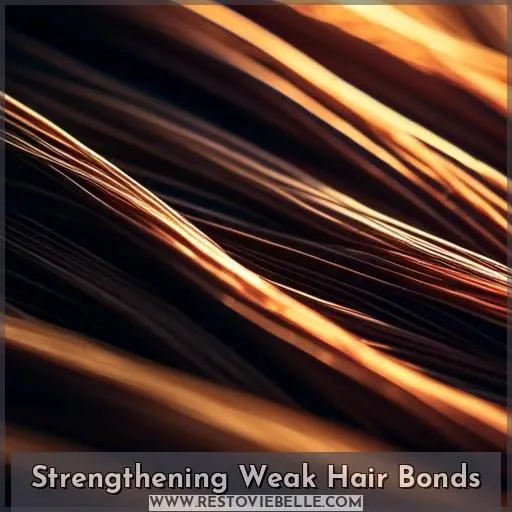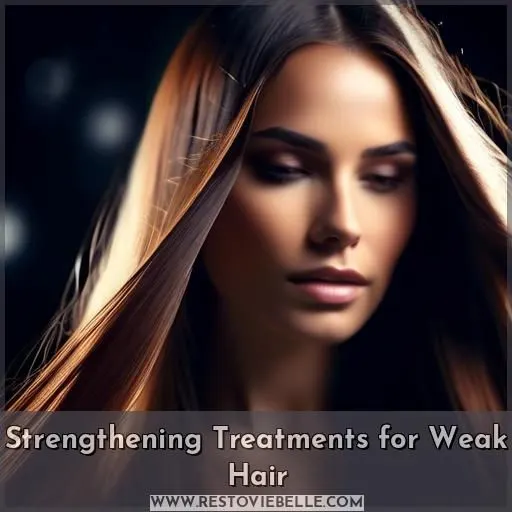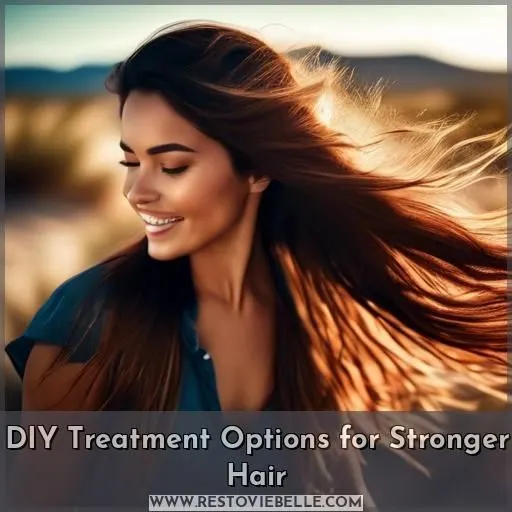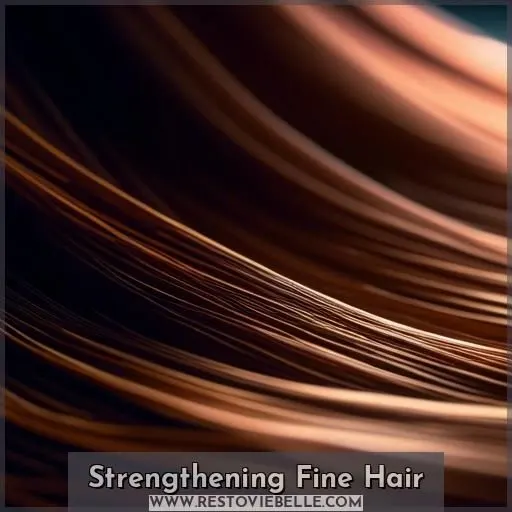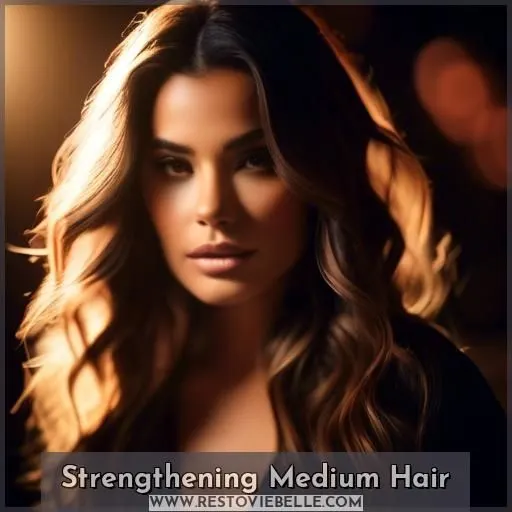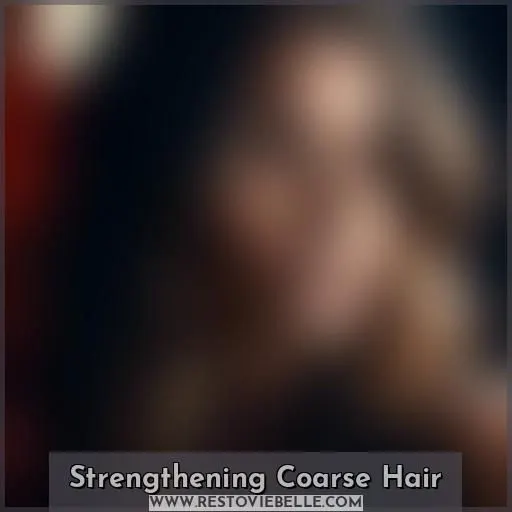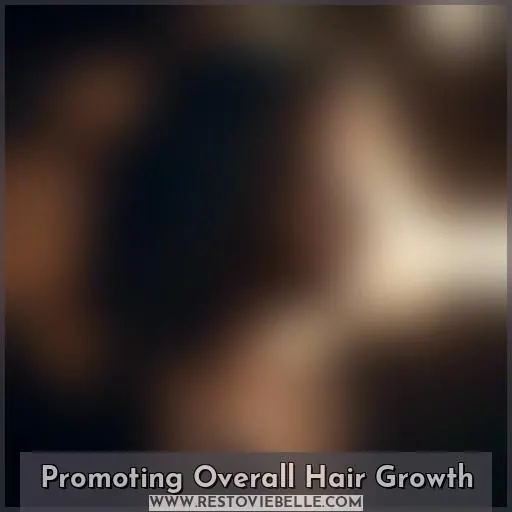This site is supported by our readers. We may earn a commission, at no cost to you, if you purchase through links.
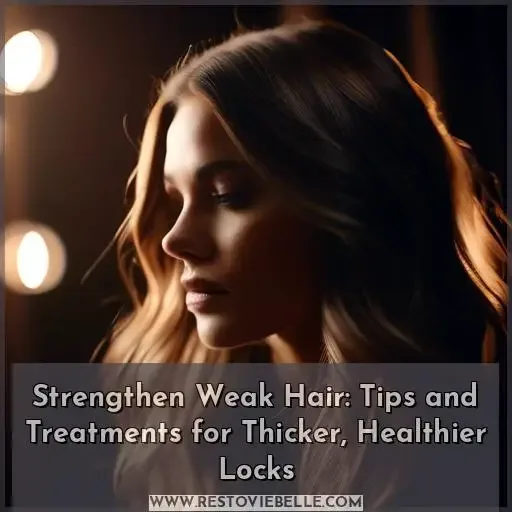
To strengthen weak hair, first address the underlying causes such as genetics, hormones, excessive styling, nutritional deficiencies, or medication. Signs of weak hair include frizz, split ends, dryness, limp strands, and thinness.
Strengthen the hair’s chemical bonds to improve resilience. Use bond-repair treatments and be sure to prevent split ends by limiting heat and using essential nutrients like vitamins A, C, D, iron, and biotin.
Try DIY options like an egg yolk mask or coconut oil. Customize your routine based on your hair type, whether fine, medium, or coarse. Taking these steps can transform your locks.
Table Of Contents
- Key Takeaways
- How to Strengthen Hair?
- What Causes Weak Hair
- Signs of Weak Hair
- Strengthening Weak Hair Bonds
- Strengthening Treatments for Weak Hair
- Preventing Split Ends
- DIY Treatment Options for Stronger Hair
- Strengthening Fine Hair
- Strengthening Medium Hair
- Strengthening Coarse Hair
- Promoting Overall Hair Growth
- Frequently Asked Questions (FAQs)
- What are the best bonding treatments for fine hair?
- How often should I use hair bonding treatments for medium hair?
- Are there any natural alternatives to hair bonding treatments for coarse hair?
- Can I use hair bonding treatments while on a vegan diet?
- How long does it take for hair bonding treatments to show results?
- Conclusion
Key Takeaways
- Address underlying causes of weak hair, such as genetics, hormones, excessive styling, nutritional deficiencies, or medication.
- Use bond-repair treatments and prevent split ends by limiting heat and using essential nutrients like vitamins A, C, D, iron, and biotin.
- Customize your routine based on your hair type, whether fine, medium, or coarse.
- Maintain a healthy scalp microbiome and consume a balanced diet rich in vitamins and minerals for hair strength.
How to Strengthen Hair?
To strengthen your hair, follow these tips:
- Brush your hair before showering to prevent breakage.
- Condition correctly by using a nickel-size drop of conditioner, focusing on the mid-shaft and ends, and leaving it on for a minute before washing.
- Use hair masks or deep conditioners at least once a week to keep strands hydrated.
- Be mindful of key ingredients, such as coconut oil, Argan oil, aloe, or spirulina, which nourish your strands.
- Eat a balanced diet rich in protein, vitamins C and E, and other nutrients that boost collagen production and strengthen hair.
- Take a deep breath and reduce stress, as a healthy scalp is essential for strong hair.
- Turn down the shower temperature to protect your hair from damage.
- Apply a leave-in styler with antioxidants to shield your strands from environmental factors.
- Don’t skip your scalp, as healthy hair starts with a healthy scalp.
By incorporating these habits into your routine, you can promote stronger, healthier hair.
What Causes Weak Hair
Your hair may be weak due to a variety of factors. Genetics, hormonal shifts, excessive styling, nutrient deficiencies, and certain medications can all contribute to fragile, damaged strands. Understanding the root causes can help you develop an effective plan to strengthen and fortify your hair.
Genetic or Hereditary Factors
Genetics play a significant role in determining hair thickness and hair loss patterns. Hereditary hair loss, also known as androgenetic alopecia, is the most common form of hair loss, affecting both men and women. This condition is caused by a sensitivity to the hormone dihydrotestosterone (DHT), which causes hair follicles to shrink and eventually stop producing new hair.
- Follicle Health: Hair follicles come in different shapes and sizes, affecting hair texture and width. Genetics influence hair thickness, with some people having wider follicles and thicker hair strands than others.
- Hair Types: Hair loss can be influenced by hair types, with some individuals being more susceptible to hair loss due to their genetic makeup.
- Hair Strengthening: To maintain hair strength, it’s essential to understand your hair type and genetics, as this can help you tailor your hair care routine to your specific needs.
- Weak Hair: Genetics can also contribute to weak hair, making it more prone to damage and breakage.
Hormonal Changes
Hormonal imbalances can result in weakened hair and hair loss. During pregnancy, hormonal shifts can make your hair thicker and more lustrous due to elevated estrogen levels. However, after childbirth, your hormone levels decline, and you may experience increased hair shedding. This is known as postpartum hair loss, which can persist for several months.
Stress can also lead to hair loss by triggering telogen effluvium, a condition where a significant number of hairs enter the resting phase, causing them to fall out. Stress-related hair loss is often temporary, but it can be upsetting and impact your self-esteem.
Scalp care is essential for maintaining healthy hair. A healthy scalp microbiome is critical for proper hair growth, and products like WeThrivv Revivv can support scalp well-being. Massaging your scalp with essential oils such as rosemary, tea tree, or coconut oil can also stimulate hair growth and alleviate stress.
To prevent hormonal hair loss, make sure you’re consuming sufficient nutrients, including vitamins A, B, C, D, zinc, and iron, which are vital for hair growth. Maintaining a balanced diet and staying hydrated can also contribute to hair health.
If you’re experiencing excessive hair loss or hair thinning, it’s crucial to consult a healthcare professional to identify the underlying cause and explore suitable treatment options.
Excessive Hair Styling
Excessive hair styling can lead to weak hair, causing damage and breakage. Here are five tips to avoid over-styling and protect your hair:
- Limit Heat Styling: Use heat styling tools sparingly and always apply a heat protectant before styling.
- Choose the Right Tools: Invest in high-quality heat styling tools that distribute heat evenly and have adjustable heat settings.
- Avoid Tight Hairstyles: Opt for loose hairstyles that don’t put excessive stress on your hair.
- Brush Gently: Avoid over-brushing, especially when hair is wet, as it can cause breakage.
- Maintain a Healthy Scalp: Keep your scalp clean and nourished to promote healthy hair growth.
Nutritional Deficiencies
Nutritional deficiencies can lead to weak hair, causing hair thinning and damage. A balanced diet, rich in vitamins and minerals, is essential for hair strength. Dietary supplements, hydration, and maintaining a healthy scalp microbiome can help reverse hair damage.
Medication or Drug Use
Medication or drug use can contribute to weak hair by causing hair loss or disrupting the hair growth cycle. Here are three ways to prevent hair damage from medication side effects and drug interactions:
- Monitor your medication: Keep track of any changes in your hair’s appearance, such as increased shedding, thinning, or brittleness, after starting a new medication. If you notice any concerning symptoms, consult your healthcare provider to discuss potential hair-related side effects and alternatives to your current medication.
- Consider hair growth supplements: Certain supplements, such as Nutrafol, can aid in hair growth by providing botanical ingredients that support hair health. These supplements may help counteract the hair-thinning effects of some medications.
- Use bond-building treatments: Bond builders can help mend and fortify weak hair by strengthening the bonds between hair strands. These treatments can be particularly beneficial for individuals experiencing hair loss due to medication or drug use.
Signs of Weak Hair
Are your hair frizzy, prone to splitting, or feeling dry and limp? These are common signs of weak hair that could use some strengthening. Fortunately, there are evidence-based tips and treatments to help revive your locks and achieve thicker, healthier hair.
Frizzy Hair
Frizzy hair is a common problem that can be caused by various factors, including humidity, styling damage, and natural hair texture. In high humidity, your hair’s outer cuticle layer may not lie smooth, flat, and tight, leading to the loss of moisture and increased porosity. This causes your hair to absorb moisture from the atmosphere, swell, and become frizzy.
To combat frizzy hair, it’s crucial to make sure your hair is well-hydrated and nourished. Here are some tips to help you manage frizzy hair:
- Protect your hair from humidity: Use hydrating shampoos and conditioners designed for your hair type to maintain moisture balance. Apply a frizz-control serum or cream to damp hair to lock in moisture and avoid vigorous towel-drying.
- Prevent heat damage: Limit the use of blow dryers and flat irons, and always apply heat protectant before styling.
- Protect your hair from the sun: Use hats or UV protectant sprays to shield your hair from the sun’s damaging effects.
- Detangle carefully: Brush your hair gently with a wide-toothed comb to prevent breakage and frizz.
- Use natural remedies: Coconut oil, aloe vera, and honey can provide a protective barrier against humidity, helping to keep your hair moisturized and less prone to frizz.
Remember that frizzy hair isn’t always a sign of unhealthy hair. Some people naturally have frizzy hair, especially those with curly or wavy hair types. However, excessive frizz can be a sign of damage or lack of hydration. To maintain healthy, frizz-free hair, focus on adequate hydration, heat protection, and gentle handling.
Split Ends
Split ends are a common issue that can lead to weak hair. They occur when the ends of your hair become damaged and frayed, often due to excessive heat styling, chemical treatments, or lack of proper care. To prevent split ends and promote hair health, consider the following tips:
- Moisturize your hair: Regularly apply a deep conditioning treatment to maintain moisture and prevent split ends.
- Protect your hair: Use heat protectants before styling with hot tools and protect your hair from the sun with hats or UV protectant sprays.
- Get regular trims: Have your hair trimmed every 6-12 weeks to remove split ends and promote growth.
- Take supplements: Ingest hair-loving vitamins and minerals like biotin and folic acid to strengthen your hair from the inside.
- Use a leave-in conditioner: Apply a leave-in conditioner to keep your hair hydrated and prevent split ends.
- Be gentle with your hair: Avoid rough handling and use a wide-tooth comb to detangle wet hair.
- Brush your hair gently: Brush your hair with care, starting from the ends and working your way up.
- Avoid excessive chemical treatments: Minimize the use of harsh chemical treatments like perms and relaxers.
- Use natural remedies: Apply a mixture of honey and coconut oil to your hair to nourish and prevent split ends.
Dry Hair
Dry hair is a common sign of weak hair bonds. To strengthen your locks, try DIY hair masks, hair slugging, hot oil treatments, and scalp massages. Incorporate nutrient-rich foods and hair oils into your diet. Use hair masks and scalp serums for added nourishment.
Limp Strands
Just like a wilted flower, limp hair signals weak follicles; revitalize with scalp massages, rinses, and nightly hair slugging.
Thin and Lacklustre Hair
Thin and lacklustre hair can be a sign of weak hair, which may be due to various factors such as genetics, hormonal changes, excessive hair styling, nutritional deficiencies, or medication use. To strengthen your hair and improve its appearance, consider implementing the following tips:
- Use a high-quality shampoo and conditioner that’s sulfate-free to maintain your hair’s natural oils and prevent breakage.
- Air dry your hair whenever possible to minimize heat damage.
- Apply a thermal protector before using heat styling tools to create a barrier between your hair and the heat.
- Use a moderate heat setting on your styling tools, as higher temperatures can cause more damage.
- Regularly use a heat protectant spray to further shield your hair from heat damage.
- Incorporate hair masks into your routine to provide deep conditioning and strengthen your hair.
- Get regular trims to remove split ends and promote healthy hair growth.
- Consider using hair growth supplements or shampoos and conditioners with botanical ingredients to support hair growth.
Brittle Hair
Brittle hair is a common issue that can be caused by various factors, including harsh shampoos, chemical treatments, heat damage, and poor diet. To prevent brittle hair, consider these tips:
- Limit hair washing: Washing hair less frequently can help maintain its natural oils, which are essential for hair health.
- Condition after every wash: Use a conditioner to provide your hair with the necessary moisture it needs.
- Avoid excessive heat: Limit the use of heat styling tools and reduce exposure to high temperatures.
- Choose gentle hair care products: Opt for sulfate-free shampoos and conditioners that are gentler on your hair.
- Eat a balanced diet: Incorporate nutrient-rich foods, such as those high in vitamins A, B, C, D, E, iron, protein, and zinc, which are essential for hair growth and health.
- Stay hydrated: Drink plenty of water to support healthy hair follicles.
- Avoid tight hairstyles: Opt for loose hairstyles that don’t put excessive tension on your hair.
Increased Breakage
Increased breakage is a common sign of weak hair. Manage stress, exfoliate your scalp, balance your diet, protect your hair from UV rays, use pre-wash treatments, and consider scalp scrubs. Stronger hair comes from regular haircuts and living proof treatments.
Shedding From the Roots
Losing hair from the roots is a typical indication of weak hair. This can be brought about by various factors, including imbalances in hormones, excessive styling, nutritional deficiencies, or underlying health issues. To strengthen weak hair and prevent excessive shedding, consider the following tips:
- Hormonal Balance: Make sure proper hormonal balance by addressing any underlying health issues, such as thyroid problems or polycystic ovary syndrome (PCOS).
- Nutrition: Eat a balanced diet rich in essential nutrients like vitamins A, D, E, iron, zinc, biotin, and selenium. These nutrients are vital for hair growth and strength.
- Deep Conditioning: Regularly use deep conditioning treatments that contain powerful ingredients and longer leave-in times to maintain a well-moisturized scalp.
- Keratin Treatment: Consider keratin treatments, which involve the application of a product containing keratin to strengthen hair and improve its overall appearance.
- Scalp Massage: Regular scalp massages can increase blood circulation to the hair follicles, promoting hair growth and strength.
- Stress Management: Reduce stress levels to prevent telogen effluvium, a condition where hair roots enter the resting phase too early, leading to excessive shedding.
- Adequate Hydration: Ensure proper hydration to maintain the health of your hair and scalp.
Tangled Hair
Tangled hair is a common issue for many, but it’s not just a cosmetic concern. Tangles can lead to breakage, split ends, and even hair loss. Here are some tips to help you manage tangles and prevent them from occurring:
- Detangling products: Use a detangling spray or leave-in conditioner to help smooth your hair and reduce tangles. These products can provide slip, making it easier to brush through your hair without causing breakage.
- Hair porosity: Understanding your hair’s porosity can help you choose the right detangling products. High-porosity hair tends to absorb moisture and products quickly, while low-porosity hair may need more time to absorb products. Adjust your detangling routine accordingly.
- Brush types: Choose a brush with flexible bristles that can glide through your hair without causing breakage. Wet brushes are a popular option for detangling, as they’re designed to be gentle on wet hair.
- Hair thinning: If you have fine or thinning hair, be gentle when detangling to avoid causing additional damage. Start at the ends and work your way up to the roots, using a wide-toothed comb or your fingers to gently separate knots.
- Hair cleansing: Make sure you’re using the right shampoo and conditioner for your hair type. Over-cleansing can strip your hair of its natural oils, making it more prone to tangling.
Strengthening Weak Hair Bonds
Hair is made up of chemical bonds that link proteins like keratin together. When these bonds are damaged or broken, hair becomes weak, brittle, and prone to breakage. Understanding the types of bonds and how they’re impacted is vital for properly strengthening and repairing hair.
Understanding Hair Bonds
Hair is a complex structure composed of protein, or amino acids, held together by various types of bonds. These bonds are essential for maintaining the hair‘s strength, elasticity, and shape. The three main types of bonds in hair are hydrogen, ionic, and covalent bonds.
Hydrogen bonds are the weakest of the three types and are responsible for the hair’s temporary shape changes. They form between hydrogen atoms and nitrogen, oxygen, or fluorine atoms, and are easily broken and reformed by water or heat.
Ionic bonds, also known as salt bonds, are responsible for about one-third of hair’s strength. They form from an electrostatic attraction between negatively and positively charged amino acids (ions) and are affected by changes in pH.
Covalent bonds are the strongest type and provide the hair’s internal structure and shape. Disulfide bonds, a type of covalent bond, primarily connect separate polypeptide chains along the width of the hair fiber and break when exposed to chemical services, oxidizing agents, and excessive heat or environmental factors.
Peptide bonds join individual amino acids together to create long polypeptide (keratin) chains, which give hair its core strength and structure.
Each type of bond plays a role in hair health and can break at different points in your hair care routine. Understanding these bonds and their functions is vital for maintaining healthy, strong hair.
How Bonds Break and Can Be Mended
Hair bonds are the microscopic connections that hold your hair together, providing strength, elasticity, and shape. They’re made up of three types: covalent (disulfide), hydrogen, and ionic (salt) bonds. Covalent bonds are the strongest and most permanent, responsible for your hair’s texture and shape. Hydrogen bonds are temporary and can be broken by water and heat, affecting hair’s elasticity and shape. Ionic bonds are also temporary and can be damaged by sudden pH imbalances.
When hair bonds are strong and unbroken, they create shiny, healthy hair strands. However, when these bonds are weakened or broken, hair appears dry, brittle, frizzy, and damaged. Damage can occur through various activities, such as heat styling, using chemical treatments, and brushing wet hair.
To mend and strengthen weak hair bonds, you can use treatments that target all three types of bonds. For example, the Triple Bond Complex is a patent-pending technology designed to repair all three types of bonds found in hair, taking a holistic approach to restore hair to its full strength and protect against future damage.
In addition to using bond-repair treatments, you can also take preventative measures to minimize bond damage. For instance, avoid excessive heat styling and use heat protectants, maintain a healthy scalp, and consume a balanced diet rich in essential nutrients for hair health.
Strengthening Treatments for Weak Hair
Bond-repair treatments are a game-changer for weak, damaged hair. They work by mending the broken disulfide bonds that lead to brittleness, frizz, and breakage, resulting in stronger, smoother strands with increased elasticity and resilience.
Bond-Repair Treatments Overview
Just as a chain is only as strong as its weakest link, your hair’s resilience hinges on the integrity of its keratin structure.
Bond damage, particularly to sulfur bonds like disulfide bonds, can leave your locks lackluster and fragile.
Enter bond-repair treatments, the knights in shining armor for your tresses. These savvy saviors, including Olaplex alternatives, work at a molecular level to mend and fortify, transforming straw-like strands into a luscious mane worthy of a hair-flip celebration.
Benefits of Bond-Repair Treatments
Bond-repair treatments can be a game-changer for weak hair. These treatments help mend damaged hair bonds, enhancing the overall strength and appearance of your locks. Here are five benefits of incorporating bond-repair treatments into your hair care routine:
- Restores hair bonds: Bonding products, such as keratin treatments and protein treatments, work to restore weakened hair bonds, resulting in a stronger and more resilient strand.
- Reduces breakage: By strengthening hair bonds, bond-repair treatments can help reduce split ends and breakage, leading to less frequent haircuts.
- Improves hair texture: Strengthening masks can help improve the texture of weak hair, making it appear thicker and more voluminous.
- Promotes hair growth: Hair supplements containing botanical ingredients can aid in hair growth by nourishing the hair follicles and promoting healthy hair growth.
- Boosts confidence: With stronger, healthier hair, you’ll feel more confident in your appearance, ready to take on the world with a smile.
Preventing Split Ends
To prevent split ends, which can weaken and damage hair strands, it’s essential to limit heat exposure from styling tools and implement appropriate heat protection measures. Furthermore, ensuring your hair receives sufficient nutrients such as vitamins A, C, D, iron, and biotin through a balanced diet is paramount for maintaining strong, healthy hair and preventing split ends.
Heat Damage Prevention Tips
To prevent heat damage and split ends, maintain a 6-inch distance between your hair and the blow dryer.
Limit blow drying to 2-3 times weekly.
Before styling, apply heat protectant.
Use lower heat settings on styling tools, and avoid concentrating heat on specific areas.
Wash your hair 2-3 times per week with a quarter-sized amount of shampoo.
Massage your scalp daily for 4 minutes, using a scalp massager.
Make sure you get enough protein in your diet.
Dry your hair gently with a microfiber towel or cotton T-shirt.
Perform hot oil treatments with coconut and avocado oil.
Essential Nutrients for Hair Strength
To bolster your hair and avert split ends, it’s essential to maintain a balanced diet abundant in vital nutrients.
Integrate foods abundant in Vitamin A, such as sweet potatoes, carrots, pumpkin, and spinach, to foster cell growth and repair.
B Vitamins, notably Biotin, found in egg yolks, liver, and salmon, contribute to robust hair growth.
Vitamin C from citrus fruits, strawberries, and bell peppers supports collagen production.
Vitamin D from fatty fish, egg yolks, and fortified foods enhances hair follicle health.
Finally, ensure sufficient iron intake from oysters, clams, eggs, red meat, lentils, and spinach to support hair growth and prevent anemia.
DIY Treatment Options for Stronger Hair
If you’re looking for a natural and cost-effective way to strengthen your hair, consider trying a DIY egg yolk hair mask. This treatment is rich in nutrients like vitamins A, E, biotin, and folate, which can help protect your hair from damage, promote hair growth, and improve elasticity.
To make an egg yolk hair mask, combine 3 egg yolks with 3-4 tablespoons of coconut oil. Apply the mixture to your scalp and roots, cover with a shower cap, and leave it on for 10-15 minutes before rinsing with cool water.
Coconut oil is also beneficial for hair health, as it can penetrate the hair shaft and provide deep conditioning, reducing protein loss and preventing breakage.
In addition to the egg yolk mask, consider incorporating nutrient-rich foods like sweet potatoes, carrots, pumpkin, spinach, and fatty fish into your diet to provide your hair with the essential vitamins and minerals it needs to thrive.
Remember to massage your scalp daily for 4 minutes with a scalp massager to improve blood circulation and stimulate hair growth. By combining these DIY treatments with a balanced diet and proper hair care routine, you can help strengthen your hair and promote healthier, thicker locks.
Strengthening Fine Hair
For those with fine hair, using clay- and oat-based shampoos can help minimize hair damage from frequent washing. Incorporating lightweight, water-based leave-in conditioners and avoiding heavy styling products will also promote hydration and strengthen fine strands.
Clay- and Oat-Based Shampoos
Venturing into the realm of exquisite hair care, clay- and oat-based shampoos appear as valiant protectors.
These shampoos aren’t mere vessels of optimism; they’re scientifically assembled companions.
Clay performs marvels by delicately purifying without removing vital oils, shielding against the dreaded split ends.
Oat, conversely, acts as a hydration champion, imbuing fine hair with moisture without burdening it.
In unison, they form a formidable alliance, guaranteeing that your tresses aren’t only pristine, but also robust and vibrant.
Hydration Tips for Fine Hair
To keep fine hair hydrated, follow these tips:
- Use leave-in conditioners: These products help maintain moisture throughout the day without weighing down your hair.
- Opt for water-based products: Avoid heavy styling products that can weigh down fine hair. Instead, choose lightweight, water-based options for detangling and hydration.
- Apply hydrating serums: Lightweight serums can provide an extra boost of hydration without adding bulk.
- Employ detangling techniques: Be gentle when brushing to avoid breakage. Use a wide-tooth comb or your fingers to detangle, starting from the ends and working your way up.
- Massage your scalp: Regular scalp massages can improve blood flow and stimulate hair growth, keeping your hair healthy and strong.
Strengthening Medium Hair
For strengthening medium hair, you’ll need to find the right balance between moisture and protein in your hair care routine. Using masks containing ingredients like shea butter for moisture and silk proteins for strength and repair can fortify strands, reduce breakage, and improve hair elasticity.
Balancing Moisture and Protein in Care Routine
Just like a tightrope walker balances on a wire, your medium hair needs you to master the art of balancing hydration and protein. This haircare balance is essential for medium hair to thrive, ensuring it’s neither too brittle nor too limp.
| Hydration Heroes | Protein Powerhouses |
|---|---|
| Aloe Vera | Keratin Treatments |
| Argan Oil | Collagen Masks |
| Hyaluronic Acid | Rice Water Rinse |
| Deep Conditioners | Biotin Supplements |
Embrace these treatments with open arms, and watch your hair transform into a luscious, envy-inducing mane.
Using Masks With Shea Butter and Silk Proteins
Using masks with shea butter and silk proteins is an excellent way to strengthen medium hair. Shea butter is known for its moisturizing and strengthening properties, which can help repair damaged hair and prevent dryness and itching of the scalp. Silk proteins, on the other hand, have bond-building properties that can reinforce the strength and structure of weakened hair strands.
Here are some tips on how to use these ingredients effectively:
- Shea Butter Mask: Apply a shea butter mask once or twice a week, depending on your hair’s needs. Massage the shea butter into your scalp and hair, let it sit for 15-20 minutes, then rinse with warm water and wash your hair with shampoo and conditioner.
- Silk Protein Mask: Combine shea butter with silk protein-rich ingredients, such as silk powder or silk peptides, to create a nourishing mask. Apply the mask to your hair, let it sit for 15-20 minutes, then rinse with warm water and wash your hair with shampoo and conditioner.
- Frequency: Use these masks as part of your regular hair care routine, aiming for at least once a week. Adjust the frequency based on your hair’s needs and the severity of damage.
- DIY Masks: Experiment with DIY masks using ingredients like eggs, yogurt, or avocado, which are rich in protein and can help repair damaged hair.
Strengthening Coarse Hair
For coarse hair types, prioritizing scalp care is essential to encourage stronger, healthier strands. Employ gentle scrubs and scalp rinses to clear follicles and maintain a suitable scalp environment. Additionally, deep conditioning with restorative ingredients like hydrolyzed elastin, castor oil, and keratin helps strengthen the hair shaft and prevent breakage.
Prioritizing Scalp Care With Gentle Scrubs
Prioritizing scalp care is essential for maintaining healthy hair.
Gentle exfoliation with scalp scrubs can eliminate impurities and dead skin cells, fostering a beneficial microbiome. Moisturizers in scrubs can also hydrate the scalp, preventing dryness and flaking.
Use a mild applicator bottle to apply shampoos directly to the scalp for maximum cleansing.
A healthy scalp is the cornerstone for vibrant, beautiful hair.
Deep Conditioning With Restorative Ingredients
Diving into the realm of deep conditioning, envision it as your hair’s private sanctuary.
Revitalizing ingredients are the esteemed attendees, restoring vibrancy to dry, unruly tresses.
Picture your hair absorbing all that nourishment like a parched sponge, evolving from arid to robust.
This isn’t a mere respite; it’s a fortitude-enhancing expedition for your mane.
With each encounter, you’re not merely addressing dryness; you’re reinforcing your follicles against impending challenges.
Bid farewell to fragility and embrace resilience.
Promoting Overall Hair Growth
To achieve thicker, healthier locks, consider these three key strategies:
- Hair Growth Supplements: Incorporate nutrient-rich supplements, such as Nutrafol, which contain botanical ingredients to support hair growth.
- Balanced Diet: Consume a diet rich in essential nutrients, including vitamins A, C, E, D, zinc, iron, and marine collagen, to nourish your hair from the inside out.
- Scalp Health and Hydration: Engage in regular scalp massages with oils like rosemary, tea tree, or coconut oil, and guarantee adequate protein intake to maintain a healthy scalp microbiome. Stay hydrated and protect your hair from sun damage with hats or UV protectant sprays.
Frequently Asked Questions (FAQs)
What are the best bonding treatments for fine hair?
For fine hair, bond-building treatments with hydrolyzed proteins and amino acids are your best bet. They’ll reinforce weakened bonds, leaving your strands stronger and more resilient. Gentle is key – those delicate locks need a featherlight touch.
How often should I use hair bonding treatments for medium hair?
For those with medium hair, we recommend using a bond-building treatment once or twice a month. This will strengthen strands and minimize damage without overdoing it. Consistency is key for healthier, more resilient hair.
Are there any natural alternatives to hair bonding treatments for coarse hair?
For coarse hair, try natural treatments like weekly deep conditioning with avocado and castor oil. These nourishing oils hydrate strands and strengthen the hair cuticle, improving hair health without harsh chemicals.
Can I use hair bonding treatments while on a vegan diet?
Absolutely, you can use hair bonding treatments while on a vegan diet! These plant-based wonders work like magic to revive your strands, leaving them stronger and more radiant than ever before. No need to sacrifice your ethics for healthy hair.
How long does it take for hair bonding treatments to show results?
You’ll typically notice hair bonding treatment results in 4-8 weeks. These strand-strengthening formulas work hard to mend damage, but give them a little time to work their magic. Stay patient – your locks will feel stronger soon!
Conclusion
Miraculous hair transformation awaits you! By addressing the underlying causes of weak hair and employing the right strengthening treatments, you can achieve thicker, healthier locks.
Fortify hair bonds, prevent split ends, and customize your routine to your hair type. With a little care and patience, you’ll strengthen your hair and reclaim the confidence that comes with having strong, resilient hair.
The journey to strong, resilient hair is within your grasp.

